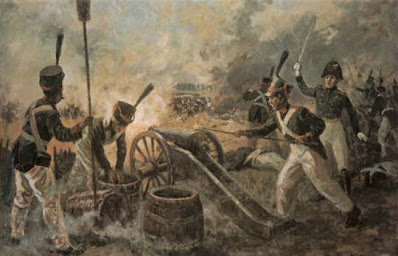I have been to the Imperial War Museum. The big attraction (and cause of the biggest queues) is the new First World War display. I hear that it's very good and do intend to visit sometime, but my destination on this visit was the large exhibition of art brought together for the centenary of the Great War.
 |
| 'Youth Mourning' |
Much of the discussion in the lead up to today's anniversary, both in real life and in the shadow world of wargaming blogs, has been expended on the causes of the war, what started it and who was to blame. Sickert's 'Integrity of Belgium' is perhaps the only exhibit here that speaks to that debate, but even then I doubt anyone would pick up the message if it weren't for the title. There is a welcome nod to the home front and to the munitions industry, but almost inevitably the majority of the art is about the suffering, the loss, the futility.

One of the few works which directly addresses the act rather than the aftermath of conflict is Sydney Carline's 'The destruction of an Austrian machine in the gorge of the Brenta valley, Italy'. Only the white plane is obvious at first, then the danger from the camouflaged hunters becomes apparent. Even here the viewer's sympathies are manipulated to be with the victim. For those who don't know the work of Carline (Stanley Spencer's brother-in-law) he was an RFC pilot himself and after becoming an official war artist painted aerial combat scenes on the Italian Front and in Mesopotamia. Biggles fans should seek him out.
 |
| W.G. Bennett |
The three artists most represented are Paul Nash, CRW Nevinson and William Orpen. The last continues the flying theme with three portraits of fighter pilots commissioned by Lord Trenchard himself. Anyone wishing to understand their lives at that time needs just to look into their eyes, powerfully drawn by Orpen.
.jpg) |
| The Doctor |
I have written here before about my admiration for Nevinson's futurist works and they are well represented. However, he became more realistic in his depictions later in the war. His most famous painting 'Paths of Glory' (the title a quote from Gray's 'Elegy in a Country Churchyard') is naturally included in the exhibition; in 1918 it was censored although Nevinson bravely showed it anyway with a strip of brown paper bearing the word 'Censored' across the middle. The Times' art critic is quoted as saying "the censor's aim being apparently to persuade us that only Germans die in this war".

These days paintings can of course be viewed online, but there is still something to be gained by seeing them first hand; sheer scale aside from anything else. In John Singer Sargent's well known painting 'Gassed' the very large original displays a detail that I hadn't noticed before. In the background, behind the crocodile of blind men being led away, a game of football is being played. The viewer, as always, can draw their own conclusion as to the meaning of this.






















.jpg)






